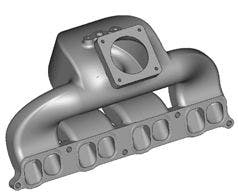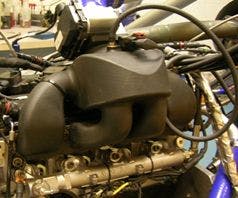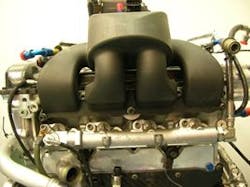Braselton, GA - The transition between the 2012 and 2013 season brought significant change to the DeltaWing. An entirely new operating team, crew, engine, and tire partner made for several new elements as the team took to the track. There is very little time between races to make necessary changes to a car, and the DeltaWing Racing Cars team and Élan Motorsports were faced with having to design a new engine from scratch.
Understanding the design and time constraints, design engineer Christian "Skitter" Yaeger turned to CRP USA to assist on the design and production of the intake manifold. Results of the efforts led to a 3D-printed intake manifold.
The new DeltaWing that took to the track in 2013 pushed the boundaries of efficiency, technology, and innovation. Engineers at DeltaWing Racing Cars, working with CRP USA and Windform, created a component that is fully functional in the race industry. The result was an intake manifold designed and developed by DeltaWing Racing Cars utilizing additive manufacturing technology with Windform SP for its construction, to operate under boost utilized in race conditions. The resulting component has been campaigned by the team since March 2013, gaining positive results and showing the tremendous potential for utilizing advanced materials technologies in partnership with 3D printing.
“We could not have made this motor happen if we couldn’t produce parts directly from CAD files,” says Christian "Skitter" Yaeger, design engineer for DeltaWing Racing Cars. "The biggest benefit is being able to print exactly what you need. We have eight odd-shaped ports in the head, and CRP USA was able to match them perfectly, with a knife edge in between."
“With the coupe version, we went slightly less wild, and a little more conventional in our design,” continues Skitter. “Over the past two years, the 3D-printed manifolds have covered over 12,000 testing and racing miles, along with 6 hours per unit running on the dyno.”
Prior to the production of the intake manifold, Windform was used on the DeltaWing to produce several different components such as electronics enclosures, and transmission seal covers with integrated, pressurized oil-feed passages.
As the engineering began the redesign of the intake manifold, a high-performance material was required to handle the heat and tension placed on the part. CRP USA introduced Windform SP to the DeltaWing engineering team for consideration. Windform SP is a composite polyamide-based, carbon-filled material.
Windform SP has excellent mechanical properties and an added advantage of increased resistance to shocks, vibrations, deformations, and—most importantly—resistance to absorption of liquids and moisture.
“The packaging constraints required by the location of the engine within the chassis requires some creative design,” says Stewart Davis, director of operations at CRP USA. “The runner lengths attach at the base of the plenum and form a complex structure that would be extremely difficult to build without using additive manufacturing. Windform SP's toughness and heat deflection temperature allow the part to be built and then raced in the endurance series. The engine is run under boost, so it sees pressure variation in addition to the vibration, shock, and temperature changes associated with racing.”
“The work done by Skitter and the DeltaWing/Élan Motorsports team is a great example of the application of Windform for a complex problem, and utilizing Additive Manufacturing to push the boundaries in racing,” concludes Davis.
Since its introduction in March 2013, the intake manifold covered 12,000 racing and testing miles.



